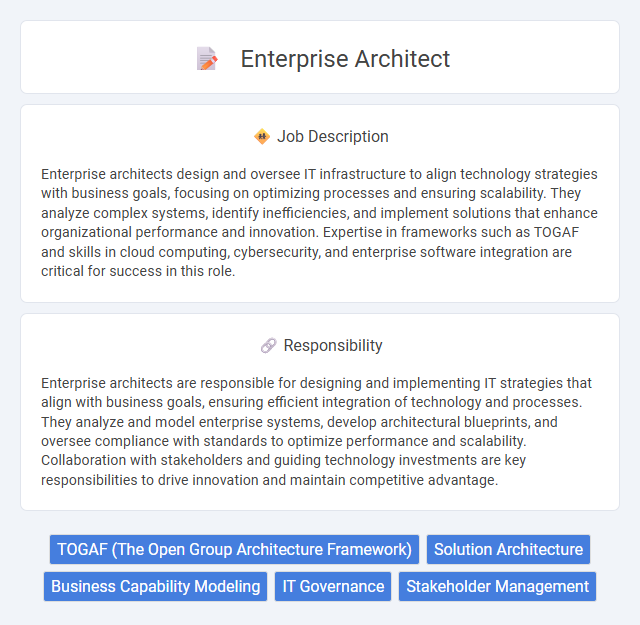
Enterprise architects design and oversee IT infrastructure to align technology strategies with business goals, focusing on optimizing processes and ensuring scalability. They analyze complex systems, identify inefficiencies, and implement solutions that enhance organizational performance and innovation. Expertise in frameworks such as TOGAF and skills in cloud computing, cybersecurity, and enterprise software integration are critical for success in this role.
Individuals with strong analytical skills and a passion for designing complex systems are likely to thrive as enterprise architects. Those who enjoy strategic planning and possess excellent communication abilities may find this role well-suited to their strengths. Conversely, people who prefer routine tasks or lack interest in aligning technology with business goals might struggle in this position.
Qualification
Enterprise architect candidates must possess a deep understanding of IT infrastructure, cloud computing, and software development methodologies. Professional certifications such as TOGAF, AWS Certified Solutions Architect, or Certified Information Systems Security Professional (CISSP) enhance credibility. Strong analytical skills, experience with enterprise-wide technology planning, and expertise in aligning IT strategies with business goals are essential qualifications.
Responsibility
Enterprise architects are responsible for designing and implementing IT strategies that align with business goals, ensuring efficient integration of technology and processes. They analyze and model enterprise systems, develop architectural blueprints, and oversee compliance with standards to optimize performance and scalability. Collaboration with stakeholders and guiding technology investments are key responsibilities to drive innovation and maintain competitive advantage.
Benefit
Enterprise architects likely provide significant benefits by aligning IT strategy with business goals, improving operational efficiency, and reducing costs through optimized technology investments. They may enhance decision-making processes by creating comprehensive architecture roadmaps that anticipate future needs and risks. Employing enterprise architects can probably lead to increased agility and innovation, supporting sustainable growth in a competitive market.
Challenge
Enterprise architects are likely to face significant challenges in aligning complex IT systems with evolving business strategies, requiring deep technical expertise and strategic vision. They may encounter difficulties in managing stakeholder expectations while ensuring scalable and secure architecture solutions. Navigating rapid technological changes and regulatory compliance could further complicate their role, demanding continuous learning and adaptability.
Career Advancement
Enterprise architects drive digital transformation by aligning technology strategies with business goals, making their role critical for organizations' growth. Mastery of cloud computing, cybersecurity, and emerging technologies enhances career advancement opportunities within tech leadership and strategic planning. Pursuing certifications like TOGAF and gaining cross-functional experience can accelerate progression to Chief Technology Officer (CTO) or Chief Information Officer (CIO) roles.
Key Terms
TOGAF (The Open Group Architecture Framework)
Enterprise Architects specializing in TOGAF leverage its comprehensive framework to design and implement scalable IT architectures that align business goals with technology strategies. Proficiency in TOGAF's Architecture Development Method (ADM) enables effective management of enterprise transformation through structured phases from architecture vision to implementation governance. Mastery of TOGAF certification demonstrates expertise in enterprise architecture principles, enhancing organizational agility and optimizing resource allocation across business and IT domains.
Solution Architecture
Enterprise architects specializing in solution architecture design scalable and efficient IT solutions by aligning business requirements with technology capabilities. They develop comprehensive architectural frameworks that ensure system integration, data flow, and application interoperability meet organizational goals. Expertise in cloud platforms, microservices, and API management enables them to create adaptable solutions that support digital transformation and operational excellence.
Business Capability Modeling
Enterprise architects specializing in Business Capability Modeling design and align organizational capabilities with strategic objectives to enhance business performance. They create comprehensive capability maps that guide investment decisions, streamline processes, and enable digital transformation initiatives. Expertise in tools like ArchiMate and experience collaborating with stakeholders ensure accurate representation of business functions and drive informed decision-making.
IT Governance
Enterprise architects specialize in aligning business strategies with IT governance frameworks to ensure compliance, risk management, and value delivery across technology initiatives. They design and implement governance models that establish clear decision-making processes, policy enforcement, and performance metrics for IT operations. Expertise in COBIT, ITIL, and ISO/IEC 38500 standards is critical for embedding strong IT governance practices within an organization's enterprise architecture.
Stakeholder Management
Enterprise architects excel in stakeholder management by aligning business objectives with IT strategies to ensure cohesive project execution. They engage cross-functional teams and executives through clear communication, fostering collaboration and addressing concerns to drive consensus. Effective stakeholder management enables enterprise architects to deliver scalable solutions that meet organizational goals and stakeholder expectations.
 kuljobs.com
kuljobs.com